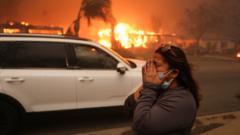As the world experiences unprecedented heat, 2024 has officially been declared the hottest year on record, with carbon dioxide (CO2) concentrations reaching troubling new heights. Recent scientific data indicates that levels of CO2 in the atmosphere rose more steeply last year than ever before, leaving global climate targets hanging in the balance. Current carbon levels are over 50% higher than those recorded before industrial activities began, primarily driven by extensive fossil fuel combustion.
Record fossil fuel emissions last year compounded the crisis, with the environmental world struggling to effectively absorb CO2 due to wildfires and drought conditions that stifled natural carbon sinks. According to experts from the Met Office, this rapid increase in CO2 is "incompatible" with the international goal established in the 2015 Paris Agreement to limit global warming to 1.5°C above pre-industrial levels.
Although the Paris Agreement metrics are based on long-term averages rather than a single year, last week's report confirming that 2024 surpassed the critical 1.5°C threshold brought urgent scrutiny to the situation. Climate scientists have stressed that to adhere to this ambitious goal, CO2 levels need to be stabilizing, yet the reverse is occurring.
The long-standing rise in CO2 levels is directly linked to human activities, especially the burning of coal, oil, and gas, as well as deforestation. Historical data spanning millions of years suggests that current levels of CO2 are unprecedented in at least the last two million years. Variations in CO2 levels from year to year can be attributed to the natural world’s capacity to absorb carbon and fluctuations in anthropogenic emissions.
Preliminary data shows that fossil fuel emissions hit new records last year, exacerbated by El Niño conditions that altered weather patterns and diminished the natural world's ability to sequester CO2 effectively. During this phenomenon, the Earth's surface waters in the eastern Pacific became exceptionally warm, further complicating the climate balance.
Additionally, persistent wildfires—some occurring in regions historically unaffected—released even more CO2 into the atmosphere. Experts are now concerned that without significant intervention, the capacity of ecosystems like the Arctic tundra and Amazon rainforest to absorb CO2 may continue to degrade, as climate change-induced challenges take their toll.
Looking ahead, the Met Office suggests that while the predicted increase in CO2 concentration for 2025 may be less pronounced than in 2024, significant deviations from the 1.5°C target will remain. The transition to La Niña conditions may provide a temporary cooldown effect, yet experts warn that the underlying CO2 buildup means further warming is inevitable.
The urgency for global action becomes stark with these latest findings, emphasizing the critical nature of addressing rising greenhouse gas emissions for the sake of preserving our planet's future.
Record fossil fuel emissions last year compounded the crisis, with the environmental world struggling to effectively absorb CO2 due to wildfires and drought conditions that stifled natural carbon sinks. According to experts from the Met Office, this rapid increase in CO2 is "incompatible" with the international goal established in the 2015 Paris Agreement to limit global warming to 1.5°C above pre-industrial levels.
Although the Paris Agreement metrics are based on long-term averages rather than a single year, last week's report confirming that 2024 surpassed the critical 1.5°C threshold brought urgent scrutiny to the situation. Climate scientists have stressed that to adhere to this ambitious goal, CO2 levels need to be stabilizing, yet the reverse is occurring.
The long-standing rise in CO2 levels is directly linked to human activities, especially the burning of coal, oil, and gas, as well as deforestation. Historical data spanning millions of years suggests that current levels of CO2 are unprecedented in at least the last two million years. Variations in CO2 levels from year to year can be attributed to the natural world’s capacity to absorb carbon and fluctuations in anthropogenic emissions.
Preliminary data shows that fossil fuel emissions hit new records last year, exacerbated by El Niño conditions that altered weather patterns and diminished the natural world's ability to sequester CO2 effectively. During this phenomenon, the Earth's surface waters in the eastern Pacific became exceptionally warm, further complicating the climate balance.
Additionally, persistent wildfires—some occurring in regions historically unaffected—released even more CO2 into the atmosphere. Experts are now concerned that without significant intervention, the capacity of ecosystems like the Arctic tundra and Amazon rainforest to absorb CO2 may continue to degrade, as climate change-induced challenges take their toll.
Looking ahead, the Met Office suggests that while the predicted increase in CO2 concentration for 2025 may be less pronounced than in 2024, significant deviations from the 1.5°C target will remain. The transition to La Niña conditions may provide a temporary cooldown effect, yet experts warn that the underlying CO2 buildup means further warming is inevitable.
The urgency for global action becomes stark with these latest findings, emphasizing the critical nature of addressing rising greenhouse gas emissions for the sake of preserving our planet's future.





















